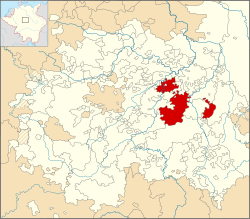.mw-parser-output .hidden-begin{box-sizing:border-box;width:100%;padding:5px;border:none;font-size:95%}.mw-parser-output .hidden-title{font-weight:bold;line-height:1.6;text-align:left}.mw-parser-output .hidden-content{text-align:left}You can help expand this article with text translated from the corresponding article in German. (July 2012) Click [show] for important translation instructions.
View a machine-translated version of the German article.
Machine translation, like DeepL or Google Translate, is a useful starting point for translations, but translators must revise errors as necessary and confirm that the translation is accurate, rather than simply copy-pasting machine-translated text into the English Wikipedia.
Consider adding a topic to this template: there are already 8,959 articles in the main category, and specifying|topic= will aid in categorization.
Do not translate text that appears unreliable or low-quality. If possible, verify the text with references provided in the foreign-language article.
You must provide copyright attribution in the edit summary accompanying your translation by providing an interlanguage link to the source of your translation. A model attribution edit summary is Content in this edit is translated from the existing German Wikipedia article at [[:de:Sachsen-Eisenberg]]; see its history for attribution.
You should also add the template ((Translated|de|Sachsen-Eisenberg)) to the talk page.
For more guidance, see Wikipedia:Translation.
This article needs additional citations for verification. Please help improve this article by adding citations to reliable sources. Unsourced material may be challenged and removed.Find sources: "Saxe-Eisenberg" – news · newspapers · books · scholar · JSTOR (March 2017) (Learn how and when to remove this template message)
Duchy of Saxe-Eisenberg Herzogtum Sachsen-Eisenberg | |||||||||
|---|---|---|---|---|---|---|---|---|---|
| 1680–1707 | |||||||||
 | |||||||||
| Status | State of the Holy Roman Empire | ||||||||
| Capital | Eisenberg, Thuringia | ||||||||
| Government | Principality | ||||||||
| Historical era | Middle Ages | ||||||||
• Partitioned from Saxe-Gotha | 1680 | ||||||||
• Extinction of line | 1707 | ||||||||
| |||||||||
The Duchy of Saxe-Eisenberg was one of the Saxon Duchies held by the Ernestine line of the Wettin Dynasty.

